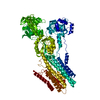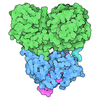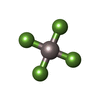+ Open data
Open data
- Basic information
Basic information
| Entry | Database: PDB / ID: 8iww | ||||||
|---|---|---|---|---|---|---|---|
| Title | hSPCA1 in the CaE1P-ADP state | ||||||
 Components Components | Calcium-transporting ATPase type 2C member 1 | ||||||
 Keywords Keywords | METAL TRANSPORT / hSPCA1 /  MEMBRANE PROTEIN MEMBRANE PROTEIN | ||||||
| Function / homology |  Function and homology information Function and homology informationGolgi calcium ion homeostasis / Golgi calcium ion transport / P-type manganese transporter activity / trans-Golgi network membrane organization / manganese ion transport / intracellular manganese ion homeostasis / P-type Ca2+ transporter / P-type calcium transporter activity / calcium-dependent cell-cell adhesion via plasma membrane cell adhesion molecules / positive regulation of Golgi to plasma membrane protein transport ...Golgi calcium ion homeostasis / Golgi calcium ion transport / P-type manganese transporter activity / trans-Golgi network membrane organization / manganese ion transport / intracellular manganese ion homeostasis / P-type Ca2+ transporter / P-type calcium transporter activity / calcium-dependent cell-cell adhesion via plasma membrane cell adhesion molecules / positive regulation of Golgi to plasma membrane protein transport / cis-Golgi network membrane / Golgi cisterna membrane / Ion transport by P-type ATPases / epidermis development / calcium ion transmembrane transport /  trans-Golgi network / intracellular calcium ion homeostasis / calcium ion transport / manganese ion binding / actin cytoskeleton organization / positive regulation of canonical NF-kappaB signal transduction / trans-Golgi network / intracellular calcium ion homeostasis / calcium ion transport / manganese ion binding / actin cytoskeleton organization / positive regulation of canonical NF-kappaB signal transduction /  Golgi membrane / Golgi membrane /  calcium ion binding / calcium ion binding /  Golgi apparatus / Golgi apparatus /  endoplasmic reticulum / endoplasmic reticulum /  ATP hydrolysis activity / ATP hydrolysis activity /  ATP binding / ATP binding /  membrane / membrane /  metal ion binding / metal ion binding /  plasma membrane plasma membraneSimilarity search - Function | ||||||
| Biological species |   Homo sapiens (human) Homo sapiens (human) | ||||||
| Method |  ELECTRON MICROSCOPY / ELECTRON MICROSCOPY /  single particle reconstruction / single particle reconstruction /  cryo EM / Resolution: 3.71 Å cryo EM / Resolution: 3.71 Å | ||||||
 Authors Authors | Liu, Z.M. / Wu, M.Q. / Wu, C. | ||||||
| Funding support |  China, 1items China, 1items
| ||||||
 Citation Citation |  Journal: Cell Res / Year: 2023 Journal: Cell Res / Year: 2023Title: Structure and transport mechanism of the human calcium pump SPCA1. Authors: Mengqi Wu / Cang Wu / Tiefeng Song / Kewu Pan / Yong Wang / Zhongmin Liu /  Abstract: Secretory-pathway Ca-ATPases (SPCAs) play critical roles in maintaining Ca homeostasis, but the exact mechanism of SPCAs-mediated Ca transport remains unclear. Here, we determined six cryo-electron ...Secretory-pathway Ca-ATPases (SPCAs) play critical roles in maintaining Ca homeostasis, but the exact mechanism of SPCAs-mediated Ca transport remains unclear. Here, we determined six cryo-electron microscopy (cryo-EM) structures of human SPCA1 (hSPCA1) in a series of intermediate states, revealing a near-complete conformational cycle. With the aid of molecular dynamics simulations, these structures offer a clear structural basis for Ca entry and release in hSPCA1. We found that hSPCA1 undergoes unique conformational changes during ATP binding and phosphorylation compared to other well-studied P-type II ATPases. In addition, we observed a conformational distortion of the Ca-binding site induced by the separation of transmembrane helices 4L and 6, unveiling a distinct Ca release mechanism. Particularly, we determined a structure of the long-sought CaE2P state of P-type IIA ATPases, providing valuable insights into the Ca transport cycle. Together, these findings enhance our understanding of Ca transport by hSPCA1 and broaden our knowledge of P-type ATPases. | ||||||
| History |
|
- Structure visualization
Structure visualization
| Structure viewer | Molecule:  Molmil Molmil Jmol/JSmol Jmol/JSmol |
|---|
- Downloads & links
Downloads & links
- Download
Download
| PDBx/mmCIF format |  8iww.cif.gz 8iww.cif.gz | 165 KB | Display |  PDBx/mmCIF format PDBx/mmCIF format |
|---|---|---|---|---|
| PDB format |  pdb8iww.ent.gz pdb8iww.ent.gz | 126.2 KB | Display |  PDB format PDB format |
| PDBx/mmJSON format |  8iww.json.gz 8iww.json.gz | Tree view |  PDBx/mmJSON format PDBx/mmJSON format | |
| Others |  Other downloads Other downloads |
-Validation report
| Arichive directory |  https://data.pdbj.org/pub/pdb/validation_reports/iw/8iww https://data.pdbj.org/pub/pdb/validation_reports/iw/8iww ftp://data.pdbj.org/pub/pdb/validation_reports/iw/8iww ftp://data.pdbj.org/pub/pdb/validation_reports/iw/8iww | HTTPS FTP |
|---|
-Related structure data
| Related structure data |  35781MC  8iwpC  8iwrC  8iwsC  8iwtC  8iwuC M: map data used to model this data C: citing same article ( |
|---|---|
| Similar structure data | Similarity search - Function & homology  F&H Search F&H Search |
- Links
Links
- Assembly
Assembly
| Deposited unit | 
|
|---|---|
| 1 |
|
- Components
Components
| #1: Protein | Mass: 97806.797 Da / Num. of mol.: 1 Source method: isolated from a genetically manipulated source Source: (gene. exp.)   Homo sapiens (human) / Gene: ATP2C1, KIAA1347, PMR1L, HUSSY-28 / Production host: Homo sapiens (human) / Gene: ATP2C1, KIAA1347, PMR1L, HUSSY-28 / Production host:   Homo sapiens (human) / References: UniProt: P98194, P-type Ca2+ transporter Homo sapiens (human) / References: UniProt: P98194, P-type Ca2+ transporter |
|---|---|
| #2: Chemical | ChemComp-CA / |
| #3: Chemical | ChemComp-ADP /  Adenosine diphosphate Adenosine diphosphate |
| #4: Chemical | ChemComp-ALF / |
| Has ligand of interest | Y |
-Experimental details
-Experiment
| Experiment | Method:  ELECTRON MICROSCOPY ELECTRON MICROSCOPY |
|---|---|
| EM experiment | Aggregation state: PARTICLE / 3D reconstruction method:  single particle reconstruction single particle reconstruction |
- Sample preparation
Sample preparation
| Component | Name: Secretory pathway Ca(2+)-transporting ATPase type 1 / Type: COMPLEX / Entity ID: #1 / Source: MULTIPLE SOURCES |
|---|---|
| Molecular weight | Experimental value: NO |
| Source (natural) | Organism:   Homo sapiens (human) Homo sapiens (human) |
| Source (recombinant) | Organism:   Homo sapiens (human) Homo sapiens (human) |
| Buffer solution | pH: 8 |
| Specimen | Embedding applied: NO / Shadowing applied: NO / Staining applied : NO / Vitrification applied : NO / Vitrification applied : YES : YES |
Vitrification | Cryogen name: ETHANE |
- Electron microscopy imaging
Electron microscopy imaging
| Experimental equipment |  Model: Titan Krios / Image courtesy: FEI Company |
|---|---|
| Microscopy | Model: FEI TITAN KRIOS |
| Electron gun | Electron source : :  FIELD EMISSION GUN / Accelerating voltage: 300 kV / Illumination mode: FLOOD BEAM FIELD EMISSION GUN / Accelerating voltage: 300 kV / Illumination mode: FLOOD BEAM |
| Electron lens | Mode: BRIGHT FIELD Bright-field microscopy / Nominal defocus max: 1600 nm / Nominal defocus min: 1000 nm Bright-field microscopy / Nominal defocus max: 1600 nm / Nominal defocus min: 1000 nm |
| Image recording | Electron dose: 50 e/Å2 / Film or detector model: GATAN K3 BIOQUANTUM (6k x 4k) |
- Processing
Processing
| Software | Name: PHENIX / Version: 1.16_3549: / Classification: refinement | ||||||||||||||||||||||||
|---|---|---|---|---|---|---|---|---|---|---|---|---|---|---|---|---|---|---|---|---|---|---|---|---|---|
CTF correction | Type: PHASE FLIPPING AND AMPLITUDE CORRECTION | ||||||||||||||||||||||||
3D reconstruction | Resolution: 3.71 Å / Resolution method: FSC 0.143 CUT-OFF / Num. of particles: 88366 / Symmetry type: POINT | ||||||||||||||||||||||||
| Refine LS restraints |
|
 Movie
Movie Controller
Controller








 PDBj
PDBj

















